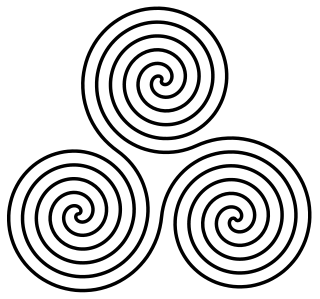Related Research Articles
In Greek mythology, Chrysothemis or Khrysothemis is a name ascribed to several characters.
In Greek mythology, Lilaea or Lilaia may refer to two different women:

A triskelion or triskeles is an ancient motif consisting of a triple spiral exhibiting rotational symmetry or other patterns in triplicate that emanate from a common center. The spiral design can be based on interlocking Archimedean spirals, or represent three bent human legs. It is found in artefacts of the European Neolithic and Bronze Age with continuation into the Iron Age especially in the context of the La Tène culture and related Celtic traditions. The actual triskeles symbol of three human legs is found especially in Greek antiquity, beginning in archaic pottery and continued in coinage of the classical period.

Etruscan art was produced by the Etruscan civilization in central Italy between the 10th and 1st centuries BC. From around 750 BC it was heavily influenced by Greek art, which was imported by the Etruscans, but always retained distinct characteristics. Particularly strong in this tradition were figurative sculpture in terracotta, wall-painting and metalworking especially in bronze. Jewellery and engraved gems of high quality were produced.
In Greek mythology, Calyce or Calycia is the name of several characters.

Peucetian pottery was a type of pottery made in the Apulian region of southern Italy by the Peucetians from the beginning of the 7th to the 6th centuries BC. It is an indigenous type. Its production area occupied the space between Bari and Gnathia. The pottery was painted only in brown and black and was characterized by geometrical ornaments, swastikas, diamonds, and horizontal and vertical lines. These samples were mainly in the Late Geometric phase of ceramics with a close ornamental pattern. The second phase of the pottery since the 6th century BC is influenced strongly by the Corinthian vase painting. This is reflected both in the ornaments, decorations in the form of radiation, as well as a change to figurative representation. The third and final phase brings a shift in production methods. The pottery was hand-formed before the arrival of the Greeks in the southernmost tip of Italy, when the potter's wheel was introduced. The painting became purely ornamental. Shown on them are decorative plants like ivy and laurel vines and palmettes. Rare images included figurative and mythological figures.
Anakles was a 6th-century B.C. Greek vase-painter whose work was closely associated with that of Nikosthenes with whom he may have been in partnership.
Galene in ancient Greek religion was a minor goddess personifying calm seas. Hesiod enumerates her as one of the 50 Nereids, sea-nymph daughters of the 'Old Man of the Sea' Nereus and the Oceanid Doris, perhaps identical with her sister Galatea.

Asterope was a Hesperid in Greek mythology.
In Greek mythology, Asterope may refer to the following characters:
In Greek mythology, Chryseis may refer to the following women:
In Greek mythology, Periclymene or Periklymene may refer to two distinct characters:
In Greek mythology, Calypso is the name of several nymphs, the most well known being:
In Greek mythology, Lipara was one of the Hesperides and sister to Asterope, Chrysothemis, Hygieia.
In Greek mythology, Xanthe or Xantho may refer to the following divinity and women:
In Greek mythology, Cissus or Kissos was a satyr who was turned into an ivy plant. His story survives only in Nonnus's early fifth century AD epic poem Dionysiaca.
In Greek mythology, Donakis was one of the seven Hesperides and sister of Aiopis, Antheia, Kalypso, Mermesa, Nelisa and Tara.
In Greek mythology, Mermesa was one of the names attested on a greek vase as part of the seven Hesperides and sister of Aiopis, Antheia, Donakis, Kalypso, Nelisa and Tara.
In Greek mythology, Nelisa was one of the seven Hesperides and sister of Aiopis, Antheia, Donakis, Kalypso, Mermesa and Tara.
In Greek mythology, Tara was one of the seven Hesperides and sister of Aiopis, Antheia, Kalypso, Donakis, Mermesa and Nelisa.
References
- Walters, Henry Beauchamp, History of Ancient Pottery, Greek, Etruscan, and Roman, Based on the Work of Samuel Birch, Volume 2, London, J. Murray, 1905.